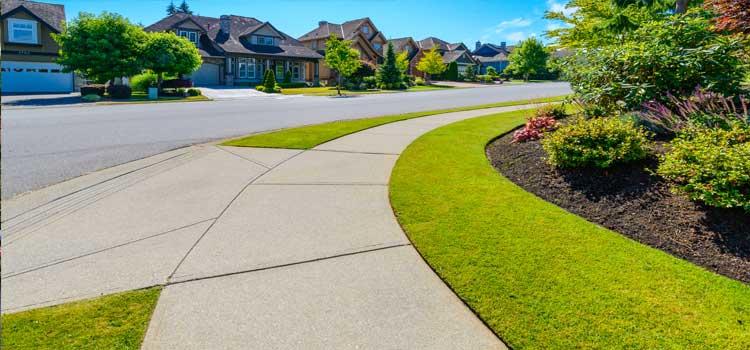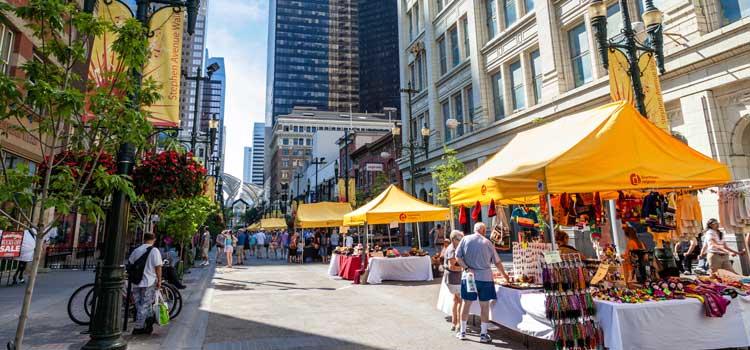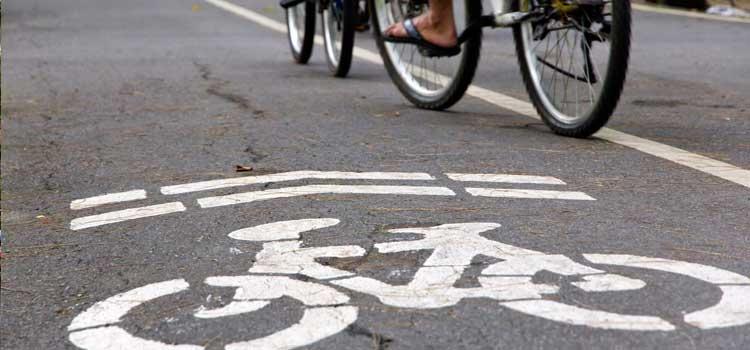
Walkable neighbourhoods offer a number of benefits that non-walkable neighbourhoods don't.
Nov. 17, 2016
You may think you’re just walking to the grocery store to pick up a carton of milk, but if you're able to wander over to the store — perhaps saying hello to a neighbour or two along the way — you're also doing a lot for your health. You’re getting a little exercise and you’re socially connected, two things that are tremendously good for you.
However, whether or not you can reap those benefits depends a lot on how your neighbourhood is built. “Walkability is a gold standard,” says Dr. Bev Sandalack, PhD, associate dean (academic) of Landscape + Planning at University of Calgary’s Faculty of Environmental Design. “If a neighbourhood is walkable there is a lot of other stuff that goes with it. It’s probably more socially connected, it’s probably safer, it’s probably better for all age groups.”

Walkable neighbourhoods offer a number of benefits that non-walkable neighbourhoods don't.
Sandalack has spent much of her career studying how neighbourhoods are built and how that impacts the people who live in them. She spent five years exploring how planning principles and practices changed over decades of growth in Calgary, from walking to driving and now back to more walking and cycling. That research, The Calgary Project: Urban Form/Urban Life, resulted in a book that outlines the city’s physical evolution and how the built environment reflects changing ideas and values over time.
As co-director of the Urban Lab research group, Sandalack sends students out of the classroom and into the city. “It got me to look at Calgary, where I grew up, differently,” says Lance Robinson, who worked in the lab and graduated with a Master of Environmental Design degree in 2013. “I learned to analyze the neighbourhoods I grew up in and wonder why we didn’t have sidewalks on both sides of the street in Edgemont but we did in Brentwood.”
If you live in North America, chances are your inner city is built on a grid, with rectangular blocks and back lanes. As you move further out from the core, you’ll likely see more mid-century “warped grids” that are lined with modest bungalows. Further out, into the suburbs, you’ll find bigger homes on cul-de-sacs and curvy streets without lanes – curvilinear neighbourhoods.
“If you go to an inner-city neighbourhood in Calgary and then go to something in the middle ring, something that was built in the 1950s or 1960s, and then you go to the very edge of the city, those are three distinct neighbourhood types that have really different block patterns,” says Sandalack.
In the inner city, you have more destinations to walk to, places like shops, services and restaurants. “And you have many, many different ways you can go,” says Sandalack. “If you go to the edge of the city to the curvilinear neighbourhoods, there are fewer destinations and it’s easy to get lost. You can’t really go from A to B.”
If you live on a curvy street, you may not be as connected to your neighbours because the houses tend to have garages in front and people drive in and disappear inside, reducing the chance of just bumping into the people who live next door.
Areas with more destinations often also have more people who live there. “We find that neighbourhoods that have higher levels of residential or population density and more destinations seem to support more walking for transportation,” says Dr. Gavin McCormack, PhD, an associate professor in Community Health Sciences at the Cumming School of Medicine and an adjunct associate professor in the Faculty of Environmental Design. He researches the relationships between physical and social environments and our health.

Walkability enhances the health of a neighbourhood.
“Having more people live in a given area means there are more people around, which may cue people to walk more, especially if they see other people walking around,” says McCormack. “The sense of safety resulting from passive surveillance — having more eyes on the street — might also encourage people to walk more in their neighbourhoods.”
"Neighbourhoods that have higher levels of residential or population density and more destinations seem to support more walking . . . "
Not surprisingly, we tend to walk more when there are well-developed streetscapes with sidewalks, crosswalks and traffic-calming devices as well as features that separate cars and pedestrians, keeping pedestrians safe.
Aesthetics also play a role in our walking habits. Trees, attractive public parks and open space, and well-maintained private gardens and lawns all encourage people to head out for a stroll. But when the area looks poorly maintained and there is “evidence of incivilities,” people are discouraged from walking for either recreation or transportation.
“Graffiti, vacant land or vacant buildings, garbage, drug paraphernalia, alcohol and beer bottles can all reduce peoples’ sense and perception of personal safety,” says McCormack.
If you have a dog, you are more likely to walk, even if there are some of those “incivilities” around your neighbourhood. “Many dog owners tend to walk regardless of their environment,” says McCormack. “Our findings suggest that if you own a dog, it may reduce the negative influence that an unsupportive built environment and even poor weather has on walking.” Dogs need to be walked, after all.
How close you live to a park, its size and quality may influence how often you head to the park to kick a soccer ball or engage in some other sort of physical activity. Research in Calgary shows that bigger parks are of “better quality,” that is, more supportive of engaging in physical activity, says Rhianne Fiolka, who worked with McCormack on her undergraduate honours thesis.
“Literature suggests that higher-quality parks result in higher-intensity physical activity, as well as increased park use,” says Fiolka. She says that in general, neighbourhoods that have bigger parks also have fewer of them. “Neighbourhoods with several smaller parks might not promote physical activity as well as a few larger, high-quality parks.” However, in neighbourhoods with mixed age groups, small parks may benefit older people who are looking for places to sit and meet with others rather than places to play sports.

Walkable neighbourhoods encourage physical activity.
As we know, living in walkable neighbourhoods — those built on a grid pattern with plenty of shops, restaurants and other destinations within walking distance — provide more opportunities for walking. “What that typically means in more walkable neighbourhoods is you have more opportunities to purchase food from various destinations,” says McCormack.
But mind what you order walking through the drive-through. Picking up unhealthy food will undo the good of the walk: “The calories you burn walking to and from that fast-food destination will not offset the calories that you take in from the burger and fries that you eat,” cautions McCormack.
"The built environment has an impact on walking and physical activity . . . "
While having more destinations close to home is better for encouraging walking, certain types of destinations could help or hinder your diet and weight— the built environment impacts overall health and wellbeing in different ways.
In the Pathways to Health research project exploring how built form impacts physical activity, diet and weight, McCormack and graduate student Maria McInerney found “some evidence” that the type of food destinations available within 400 metres of home can impact the quality of your diet.
“Based on previous findings, we have a pretty good sense that what we’re going to find is that the built environment has an impact on walking and physical activity,” he says. “However, the evidence is mixed with regard to the built environment’s role in influencing diet and weight status.”
To answer those and other questions, researchers across campus have come together in an interdisciplinary project, HealthyHoods: A better life in cities, to build on the body of work about healthy neighbourhoods.
“The World Health Organization defines health as not just the absence of illness, but physical, mental, and social well-being,” says Sandalack. “We are trying to understand the relationship between health and the entire built environment from whole cities to neighbourhoods to streets, and how that affects people of all age groups.”
Dr. Patricia Doyle-Baker, DPH, has been thinking about that relationship for decades. She’s an associate professor in the Faculty of Kinesiology and adjunct associate professor in the Faculty of Environmental Design.
“We know that public health agencies have obesity and physical inactivity on their radar screens and they support programs relating to increased physical activity at all ages and demographics,” says Doyle-Baker. “If the built environment is modified to encourage more physically active travel behaviour, we may be able to improve individual health.”
While the correlation between a walkable grid neighbourhood design and better health is well-known, the HealthyHoods research is diving deeper, to look at things like how neighbourhoods affect your weight and incidence of diseases such as diabetes. “There are so many determinants,” says Sandalack, pointing to a recent Finnish study that found the further smokers had to walk to buy cigarettes the more likely they were to quit.
“Your neighbourhood can affect your health.”
And a walkable neighbourhood is especially important for children. “What kind of quality of life does a kid have if they don’t have a park they can walk to, they can’t walk to school or if there are no sidewalks,” says Sandalack. “It really influences a lot of things.”
“Your neighbourhood can affect your health,” says Sandalack. “Ultimately it has an economic impact because the fewer people who are sick, the less drain it is on public health and health care system.”
– – – – –
Participate in a research study
– – – – –
Dr. Beverly Sandalack, PhD, is a professor and an associate dean (academic) of Landscape + Planning with UCalgary’s Faculty of Environmental Design. She is also a co-director of the Urban Lab, a research group dealing with urban design, landscape architecture, community design, and urban development issues. View Beverly Sandalack's publications
Dr. Gavin McCormack, PhD, is an associate professor in UCalgary's Department of Community Health Sciences, Cumming School of Medicine, and is an adjunct associate professor in the Faculty of Environmental Design. View Gavin McCormack's publications
Dr. Patricia Doyle-Baker, DrPH, is an associate professor in UCalgary's Faculty of Kinesiology, an adjunct associate professor with the Faculty of Environmental Design, and a member of the O’Brien Institute for Public Health. View Patricia Doyle-Baker's profile